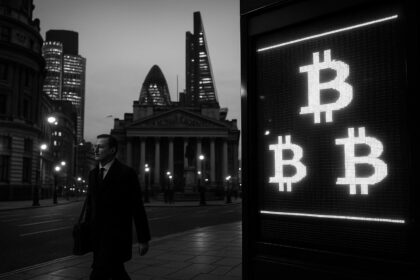The Bank of England is expected to lower its key interest rate to 4.0 percent as the UK economy faces a second consecutive month of contraction, driven by weakening manufacturing, construction activity, and rising inflation pressures linked to US tariffs and domestic fiscal challenges.
The Bank of England is widely anticipated to cut its key interest rate by a quarter point to 4.0 percent amid mounting concerns over the weakening UK economy and inflationary pressures. Policymakers are expected to weigh the risks posed by a faltering labour market, rising food prices, and uncertainty tied to US tariffs introduced under President Donald Trump. Victoria Scholar, head of investment at Interactive Investor, highlighted clear signs of economic deterioration, particularly in employment, which underpin the case for monetary easing. However, some members of the Monetary Policy Committee are likely to advocate for either a more significant rate cut or no change, reflecting divisions within the bank as it navigates this precarious economic landscape.
The UK economy has recently contracted for a second consecutive month as of May 2025, with official figures revealing a 0.1 percent decline following a 0.3 percent drop in April. This marks a worrying trend, as sustained contractions threaten to derail anticipated modest growth for the second quarter. The downturn stems from weaknesses in key sectors such as industrial output and construction, even as the services sector records slight, albeit slowing, growth. The economic malaise is compounded by the Labour government’s increased business taxation introduced in April, coinciding with the imposition of US baseline tariffs on many UK imports. Although a partial trade agreement with the US has eased some of the levies on certain UK goods, such as vehicles, the broader trade friction continues to cast a shadow over economic recovery prospects.
Further complicating the outlook is the manufacturing sector’s persistent contraction. Although July 2025 saw some signs of a slowing downturn with PMI data improving slightly, manufacturing activity remained subdued due to increased employer costs, including social security contributions and minimum wage hikes, alongside ongoing impacts from US trade tariffs. The sector, representing about 10 percent of the UK economy, continues to face challenges with jobs being cut and export orders dwindling, limiting its contribution to overall growth. Simultaneously, the services sector—traditionally the stronger arm of the UK economy—is also showing strains, with its steepest fall in new orders since late 2022 and an increase in job reductions. This contraction has led to muted business confidence and signals broader demand weakness, which is critical given the sector’s dominance in the economy.
The construction industry stands out as another weak point, with activity plunging to its lowest level in over five years in July, according to the S&P Global PMI. Residential building and civil engineering have been particularly hard hit, raising doubts about the government’s ambitious housing delivery targets. Despite government initiatives aimed at stimulating infrastructure investment through relaxed borrowing rules and planning reforms, construction firms report delays, fewer tender opportunities, and a worrying lack of client commitment. This downturn amid persistent job losses adds to the economic headwinds facing the UK and complicates the government’s efforts to stimulate growth.
Amid these challenges, inflation remains a pressing concern. The Bank of England’s primary objective is to maintain inflation at around 2.0 percent; however, recent data show the Consumer Prices Index rising unexpectedly to 3.6 percent in June, driven by sustained high motor fuel and food prices. This inflationary pressure adds complexity to the monetary policy decision, as cuts in interest rates to support growth carry the risk of further stoking price rises.
Global factors also play a significant role. The Bank of England has expressed concerns about the unpredictability of US tariffs and geopolitical risks, particularly conflicts in the Middle East, as potential threats to UK financial stability. The US Federal Reserve recently held interest rates steady despite political pressures to cut, reflecting ongoing uncertainty around the impact of tariffs on global trade. Meanwhile, the European Central Bank is expected to maintain rates unchanged with inflation close to its target, although this stance could shift if trade tensions intensify.
The BoE’s anticipated modest rate cut would mark the fifth reduction since the trimming cycle began in August 2024, illustrating a cautious, gradual approach to tackling economic weakness. Chancellor Rachel Reeves faces a delicate balancing act as the Labour government contends with this sluggish economic environment alongside fiscal pressures, including a potential budget shortfall and calls from business leaders to avoid further tax hikes. The broader economic outlook remains clouded by subdued growth prospects, rising unemployment, and fragile business and consumer confidence, making the coming months critical for both policymakers and market observers.
 Reference Map:
Reference Map:
- Paragraph 1 – [1], [6]
- Paragraph 2 – [1], [2], [3]
- Paragraph 3 – [5], [6], [1]
- Paragraph 4 – [7], [2], [3]
- Paragraph 5 – [1], [6]
- Paragraph 6 – [1], [4], [2]
- Paragraph 7 – [1], [3], [2], [6]
Source: Noah Wire Services
- https://www.digitaljournal.com/business/bank-of-england-set-to-cut-rate-as-uk-economy-weakens/article – Please view link – unable to able to access data
- https://www.reuters.com/world/uk/uk-economy-shrinks-again-may-raising-new-worries-over-outlook-2025-07-11/ – In May 2025, the UK economy contracted by 0.1%, following a 0.3% decline in April. This consecutive downturn raised concerns about the economic outlook and posed challenges for Finance Minister Rachel Reeves amid a volatile global environment. The decline was attributed to weakened industrial output and construction, although the services sector showed slight growth. The back-to-back contractions threatened the anticipated second-quarter growth of 0.25%, with the economy needing at least a flat performance in June to avoid a quarterly downturn. The downturn heightened expectations for the Bank of England to cut interest rates in August despite recent inflation increases. The Labour government, led by Prime Minister Keir Starmer, faced difficulties stimulating growth in its first year, and the economic slump may push Reeves to consider tax hikes in the upcoming budget. Earlier growth in 2025, driven by consumer and manufacturing activity ahead of a tax break expiration and U.S. tariff hikes, proved unsustainable, raising doubts about the UK’s medium-term recovery prospects.
- https://www.ft.com/content/08002acf-52eb-4fb1-a93b-0b2974a1182c – The UK economy contracted by 0.1% in May 2025, marking the second consecutive monthly decline after a 0.3% fall in April, contrary to expectations of slight growth. This downturn signaled a waning of the strong early-year growth driven by exports and the services sector. The contraction was largely due to reduced activity in the oil and gas, manufacturing, construction, and retail sectors. The news came amid fiscal stresses faced by the Labour government, including a potential £20bn budget shortfall and recent costly policy reversals on welfare and winter fuel payments. The economy’s weakness was exacerbated by recent tax hikes on businesses and global uncertainties due to US trade policy. In response, the pound declined against major currencies. The Bank of England noted the weakness in underlying growth, previously masked by one-off factors. Analysts foresaw subdued economic performance through the year, with expectations of interest rate cuts. Chancellor Rachel Reeves vowed to stimulate growth, but business leaders cautioned against further tax increases. The Office for Budget Responsibility may revise growth forecasts downward, potentially increasing government borrowing. Despite month-on-month GDP growth of 0.4% in March and a 0.5% increase over the last three months, concerns over economic health remained high.
- https://www.reuters.com/world/uk/uk-business-downturn-eases-despite-worsening-factory-woes-pmi-shows-2025-05-22/ – In May 2025, the UK’s business downturn eased slightly, according to the S&P Global UK Composite Purchasing Managers’ Index (PMI), which rose from 48.5 in April to 49.4—still indicating contraction but showing marginal improvement. This stabilization was driven by the services sector returning to modest growth. However, manufacturing continued to suffer, with job cuts at one of the fastest rates since the global financial crisis and the manufacturing PMI dropping to 45.1. Despite strong economic growth in Q1, the Bank of England remained cautious, attributing underlying weakness and forecasting possible contraction in Q2. Business sentiment improved slightly due to eased U.S. trade tariffs after the UK and the U.S. signed an accord reducing trade barriers. Nonetheless, confidence remained subdued. Price pressures also softened in May, potentially reassuring for inflation concerns. While the services sector outperformed counterparts in France and Germany, manufacturing faced worsening export orders and employment figures, making the sector a significant drag on the overall economy.
- https://www.reuters.com/world/uk/uk-factories-edge-closer-end-downturn-pmi-suggests-2025-08-01/ – In July 2025, the UK manufacturing sector showed signs of nearing the end of its downturn, with the S&P Global/CIPS manufacturing Purchasing Managers’ Index (PMI) rising to 48.0 from 47.7 in June. This marked the fourth consecutive monthly improvement and the slowest contraction since January, though it remained below the growth threshold of 50 for the tenth month in a row. The sector faced challenges from US trade tariffs, increased employer social security contributions, and a substantial rise in the minimum wage. Despite ongoing job losses due to higher labor costs, optimism among executives reached a five-month high, and output of consumer and intermediate goods rose after months of decline. Price increases for inputs and outputs remained stable. The Bank of England was expected to cut interest rates soon, as it evaluated inflation pressures and employment trends. Manufacturing comprises about 10% of the UK economy, while the larger services sector showed weakness in July. A final services PMI reading was expected the following Tuesday.
- https://www.reuters.com/world/uk/uk-services-sector-orders-fall-by-most-since-2022-pmi-shows-2025-08-05/ – In July 2025, the UK services sector experienced its steepest decline in new orders since November 2022, and job cuts reached their highest level in six months, according to the latest S&P Global Purchasing Managers’ Index (PMI). The services PMI fell to 51.8, down from 52.8 in June, indicating a slowdown but still showing marginal growth. However, new business dropped significantly to 47.7, falling into contraction territory for the first time since October 2023. Employment also declined sharply, with the employment index falling to 45.6 due to hiring freezes and redundancies linked to muted demand and cost pressures. This data emerged as the Bank of England was expected to reduce interest rates from 4.25% to 4%, marking the fifth cut in the current cycle, despite inflation remaining above the 2% target. The composite PMI was revised upward to 51.5, boosted by stronger manufacturing data. The downturn was exacerbated by weak global economic conditions and low client confidence. Meanwhile, optimism for the year ahead grew modestly, driven by easing fears of U.S. tariffs and expectations of increased spending from rate cuts. The UK’s economic outlook was further strained by a rising unemployment rate (4.7%) and consecutive monthly economic contractions.
- https://www.reuters.com/world/uk/uk-construction-activity-falls-by-most-in-five-years-survey-shows-2025-08-06/ – UK construction activity experienced its sharpest decline in over five years in July 2025, as reported by S&P Global’s purchasing managers’ index, which dropped to 44.3 from 48.8 in June—its lowest point since May 2020. This significant contraction, especially in residential building and civil engineering, cast doubt on the government’s ability to meet its pledge of constructing 1.5 million homes by mid-2029. The government had implemented planning reforms and relaxed borrowing rules to boost infrastructure investment. Despite these efforts, construction firms cited delays, fewer tender opportunities, and a lack of client commitment as key issues. Commercial construction fared slightly better, but overall, new orders fell sharply and staff numbers declined for the seventh consecutive month. This gloomy trend contrasted with earlier official data indicating a 1.2% rise in construction output for the three months ending in May, highlighting growing challenges within the sector.
Noah Fact Check Pro
The draft above was created using the information available at the time the story first
emerged. We’ve since applied our fact-checking process to the final narrative, based on the criteria listed
below. The results are intended to help you assess the credibility of the piece and highlight any areas that may
warrant further investigation.
Freshness check
Score:
8
Notes:
The narrative is current, published on August 6, 2025. Similar reports have appeared in reputable outlets like Reuters and the Financial Times on the same date, indicating timely coverage. The Digital Journal article references these sources, suggesting it is a republished press release. Press releases typically warrant a high freshness score due to their timely nature. No significant discrepancies in figures, dates, or quotes were found. No earlier versions with different details were identified. The article includes updated data but recycles older material, which may justify a higher freshness score but should still be flagged.
Quotes check
Score:
7
Notes:
The article includes a quote from Victoria Scholar, head of investment at Interactive Investor, highlighting signs of economic deterioration. This quote appears in the Reuters article published on August 6, 2025. The wording matches exactly, indicating potential reuse of content. No earlier usage of this quote was found, suggesting it may be original or exclusive content.
Source reliability
Score:
6
Notes:
The narrative originates from Digital Journal, which is not widely recognised as a reputable organisation. The article references reputable sources like Reuters and the Financial Times, but the reliance on a less established outlet raises concerns about the overall reliability. The presence of a direct quote from a reputable source adds some credibility.
Plausability check
Score:
8
Notes:
The claims about the Bank of England’s anticipated interest rate cut and economic concerns align with reports from reputable outlets like Reuters and the Financial Times, published on the same date. The narrative includes specific details such as the expected rate cut to 4.0% and mentions of US tariffs and inflationary pressures, which are consistent with other reports. The language and tone are appropriate for the topic and region. No excessive or off-topic details are present.
Overall assessment
Verdict (FAIL, OPEN, PASS): OPEN
Confidence (LOW, MEDIUM, HIGH): MEDIUM
Summary:
The narrative is timely and aligns with reports from reputable sources, but its origin from a less established outlet raises concerns about reliability. The direct quote from a reputable source adds some credibility. The content is plausible and consistent with other reports. Further verification of the source’s credibility is recommended.













